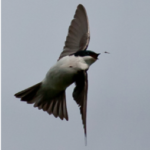

- Appearance:tiny bill, long wings, white underside, short squared tail; males (left) have cobalt blue backs, black wings and tail; females (right) have gray feathers with a blue hue on back
- Length:4-6 inches ( about .5 foot)
- Wingspan: 12-14 inches (about 1 foot)
- Status:common, but populations declined 49% 1966-2014
- Threatened by deforestation and insecticide use
- Habitat
- Fields, marshes, shorelines, wooded swamps, beaver ponds, etc.
- Prefer areas with plenty of trees, especially during breeding season

- When humans remove trees from a forest, even dead ones, they are removing potential nesting sites for tree swallows
- Nest boxes have allowed tree swallows to expand their range and compensates for loss of trees in breeding grounds
- Found seasonally across North and Central America
- Diet
- Mainly eat flying insects, but also eat berries during colder months

- This makes them an eco-friendly pest control service
- Forage on the fly, often in large flocks
- Like other swallows, tree swallows are acrobatic fliers
- Often skim aquatic insects off the water’s surface
- Also bathe by skimming water and dipping under surface
- May catch insects up to 40 feet off ground
- One adult tree swallow can eat 2,000 insects in a day
- During the breeding season eat high-calcium items like fish bones, crayfish exoskeletons, clamshells, and eggshells of larger birds such as gulls
- Mainly eat flying insects, but also eat berries during colder months
- Migration
- Spring migration begins March-April to northern half of the U.S. and Canada
- Fall migration begins July-August to southern U.S., Central America, Cuba
- Fly during the day and roost in large flocks, up to hundreds of thousands, at night
- A few year-round populations are found along Chesapeake Bay and California
- Tree swallows glide more than any other swallow species
- Flies at speeds of 15-25 mph
- Nesting
- Tree swallows are extremely social, and often give chirping calls
- Breeding pairs nest together, with some “floaters” who do not have mates
- Nest in old trees in abandoned nest cavities
- Cannot build own cavities – use abandoned ones (ex. old woodpecker nest)
- Nest boxes can also attract tree swallows
- Due to nesting habits, along with barn swallow, tree swallow is one of most studied bird species in North America
- Males display to females by showing off feathers and singing
- During early nesting season, tree swallows play with feathers -fly above the nest holding feather in bill; sometimes this leads to chases, if feather is dropped, aerial free-for-all to see which bird retrieves it begins
-
- May mate with another for one or several years, but are more loyal to nesting site than to mate – males have been seen with two females and this species is also known for having secret mates (usually females with floaters)
- Female does most of nest building
- Nest made from grass, pine needles, mosses, rootlets, aquatic plants, animal hair, and small pieces
 of plastic
of plastic - Both mates line nest with feathers, many of which are molted from another species
- Nest made from grass, pine needles, mosses, rootlets, aquatic plants, animal hair, and small pieces
- Due to shortage of nest cavities, males are highly territorial and chase/dive bomb intruders
- Have been known to swoop at/ swarm people
- Average brood is 4-7 pale pink – white eggs, females often have 2 broods, but 2nd family is smaller
- Both parents feed and protect hatchlings
- Fledglings learn to fly 18-2 days after hatching
- Juveniles display brown feathers, sometimes with a brown band across breast
- Males and females look the same until they begin to mature, breed after 1 year
- Average lifespan is 3 years, but the oldest tree swallow was about 12 years old






